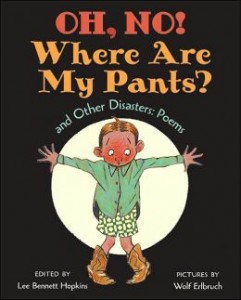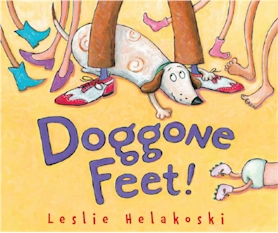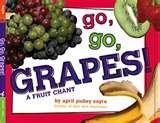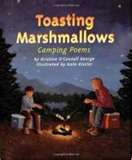Oh, No! Where Are My Pants? and Other Disasters: Poems
 Poetry doesn’t have to be “roses are red, violets are blue…” As David Lubar wrote in his young adult novel, Sleeping Freshmen Never Lie, “There are as many types of poems as there are types of food. As many flavors, you might say. To claim you don’t like poetry because you hate ‘mushy stuff’ or things you don’t immediately understand is like saying you hate food because you don’t like asparagus.”
Poetry doesn’t have to be “roses are red, violets are blue…” As David Lubar wrote in his young adult novel, Sleeping Freshmen Never Lie, “There are as many types of poems as there are types of food. As many flavors, you might say. To claim you don’t like poetry because you hate ‘mushy stuff’ or things you don’t immediately understand is like saying you hate food because you don’t like asparagus.”
April is National Poetry Month, but don’t relegate poems to just one month – share all kinds of poetry all year long! (If you do, you can check Range of Reading off your Common Core Standards list!) One of my go-to poetry books is Oh, No! Where Are My Pants? and Other Disasters: Poems edited by Lee Bennett Hopkins with pictures by Wolf Erlbruch. These “disaster” poems range from funny to poignant, and your kids will find at least one to which they can totally relate.
For example, here’s one titled “Oh, No!” by Katie McAllaster Weaver:
“Hello apple!
Shiny red.
CHOMP. CHOMP.
Hello worm.
Where’s your head?”
and here’s part of one called “My Friend is Gone” by Lillian M. Fisher:
“A hug, a tear, and you are gone.
Your swing is missing from the lawn.
Your house is silent, dark and lone.
Your window says no one is home.”
Poetry is meant to be read aloud, so read Oh, No! Where Are My Pants? and Other Disasters: Poems to your class and then choose one or two of your favorite poems to read aloud again. Talk with your students about why you liked that particular poem. Encourage your students either to choose a poem to practice reading or to write a disaster poem of their own. Then, have a disaster poetry slam where you and each of your students read a poem aloud expressively to the class. You can bring a stool for kids to sit on, and a beret to wear, and students can snap for each other instead of clap (I like to teach them phrases like “cool cat” and groovy, man” because it makes me giggle.) Your students will build their reading fluency (another Common Core Standard checked off!) and find that poetry isn’t just mushy love stuff.
Read More
Doggone Feet is Doggone Fun!
 There are many perks to being a children’s librarian (no overdue fines has saved me a bundle over the years) but one of the best parts of my job is getting to know supah-cool authors and illustrators like Leslie Helakoski. Leslie is a Michigan treasure I’ve had the pleasure of knowing for years, and I’m geeked to share her brand new book with you: Doggone Feet.
There are many perks to being a children’s librarian (no overdue fines has saved me a bundle over the years) but one of the best parts of my job is getting to know supah-cool authors and illustrators like Leslie Helakoski. Leslie is a Michigan treasure I’ve had the pleasure of knowing for years, and I’m geeked to share her brand new book with you: Doggone Feet.
Dog follows a pair of feet home from the park one day and finds her perfect place under the table. Life is good until two more feet come on the scene:
“They’re twirling leg twisters, toe-tapping kiss-kissers,
rule-listing insisters of doggy shampoos.”
So now the space under the table includes the dog and two sets of two feet, until another pair come along – tiny baby feet. As the family grows the dog must accommodate more pairs of feet in her shrinking space, and she’s not sure she likes the new additions. In the end, though the space under the table is crowded and cramped, the message is clear: families always make room for more.
The first time I read this book, I immediately thought how it perfect it would be for a math lesson. If there were two dogs and three humans, how many feet would be under the table? It’s also a great book to talk about point of view – both figuratively and literally. The story is told from the dog’s perspective, and we don’t see the faces of the humans, just their feet, until the end of the book. You can talk with your students about author/illustrator’s Craft and Structure – why did Ms. Helakoski choose to frame all the illustrations from this different point of view? How might a mouse see life under a dinner table, or a fly over a school cafeteria table at lunchtime? It’d be fun to have students spend a writing session on the floor under their desks, to inspire them to write and draw from a different point of view.
Then I saw the terrific trailer that Leslie’s son, Connor, made for her book:
How cool would it be to combine book-trailer technology with a math lesson centered around Doggone Feet?! Using a free app like Educreations on the iPad or a program like iMovie on computers, students could make a mini-movie to retell the events of the story (check off Key Ideas and Details on your Common Core State Standards score card) either by drawing the action or physically acting it out, adding up the feet as you go. With all the wonderful rhyme and wordplay, it’d be great for Reader’s Theater! Doggone Feet will be so doggone much fun for your students!
For more information, please visit Leslie’s website at helakoskibooks.com.
Read MoreGo, Go, Grapes!
 Hip, hip, hooray for April Pulley Sayre and Go, Go, Grapes! A Fruit Chant! How do you make healthy eating fun? With Sayre’s vibrant photos of fruits taken at her local farmer’s market paired with her contagious rhymes:
Hip, hip, hooray for April Pulley Sayre and Go, Go, Grapes! A Fruit Chant! How do you make healthy eating fun? With Sayre’s vibrant photos of fruits taken at her local farmer’s market paired with her contagious rhymes:
“Nectarines, tangerines,
hit the spot.
Glum? Go plum.
Or apricot!”
Start your lesson by asking students, “What do you think a mangosteen is? Or a pomegranate?” Read Go, Go Grapes! and see if your kids can discover what those uncommon words mean. Reread the book and encourage kids to chime in (“Fruit is fun!”) Next, play “Cross the Line”: have all the kids stand on one side of the classroom and imagine an invisible line down the middle of the room – or put down tape if your maintenance team won’t go bananas. Say “Cross the line if you’ve tried kiwi,” and go through the fruits listed in the book. If you have time and funds, bring in some fruits for kids to try! (Check for fruit allergies first – some kids are allergic to certain berries.) Take photos of the fruits and have kids use those Logic Smarts to sort the photos – by color, or by which they liked and which they didn’t. With all the gorgeous colors of fresh produce, you can make a “color wheel” using fruits – challenge kids to eat a rainbow! Go, Go, Grapes, hooray for healthy eating, and super job, Ms. Sayre!
For more information, visit aprilsayre.com.
Read MoreMake Poetry Delicious with “Toasting Marshmallows”
 I’ve had the pleasure of teaching poetry lessons to more than 175 students this week, and one sure-fire hit book I shared was Toasting Marshmallows: Camping Poems written by Kristine O’Connell George and illustrated by Kate Kiesler. Before I shared the title poem with the students, I told them how eager I am to go camping this summer. Amidst waving hands and shouts of “Me, too!” I talked about my memories of campfires – the smoky smell of burning wood, the welcome warmth after the sun goes down, and, of course, the requisite toasting of the marshmallows. I read aloud Kristine George’s poem in which we hear about two kinds of marshmallow toasters – those who like to patiently roast the marshmallow until the “pillowed confection” becomes “golden perfection” and those who shove ’em on a stick, burn ’em, flick off the soot, and eat ’em, char and all. The only thing that could’ve made the kids more eager to get their hands on this book when I was done with the lesson would’ve been to bring in marshmallows and build a campfire on the playground (a librarian can dream, can’t she?)
I’ve had the pleasure of teaching poetry lessons to more than 175 students this week, and one sure-fire hit book I shared was Toasting Marshmallows: Camping Poems written by Kristine O’Connell George and illustrated by Kate Kiesler. Before I shared the title poem with the students, I told them how eager I am to go camping this summer. Amidst waving hands and shouts of “Me, too!” I talked about my memories of campfires – the smoky smell of burning wood, the welcome warmth after the sun goes down, and, of course, the requisite toasting of the marshmallows. I read aloud Kristine George’s poem in which we hear about two kinds of marshmallow toasters – those who like to patiently roast the marshmallow until the “pillowed confection” becomes “golden perfection” and those who shove ’em on a stick, burn ’em, flick off the soot, and eat ’em, char and all. The only thing that could’ve made the kids more eager to get their hands on this book when I was done with the lesson would’ve been to bring in marshmallows and build a campfire on the playground (a librarian can dream, can’t she?)
Kristine George has a teacher’s guide full of cool extension ideas for Toasting Marshmallows: Camping Poems on her website: www.kristinegeorge.com. I love the idea of bringing in flashlights to use while writing poems like the four haiku about flashlights George included in her book, or working with metaphor in a writing-skills lesson. George compares the flashlight beam in the dark to a round stepping stone. What else might a flashlight beam be like? Turn off the lights, turn on the flashlights, and let the brainstorming begin! After sharing this book of poetry with your kids, you’ll hear lots of “S’more! Read s’more!”
Read More






